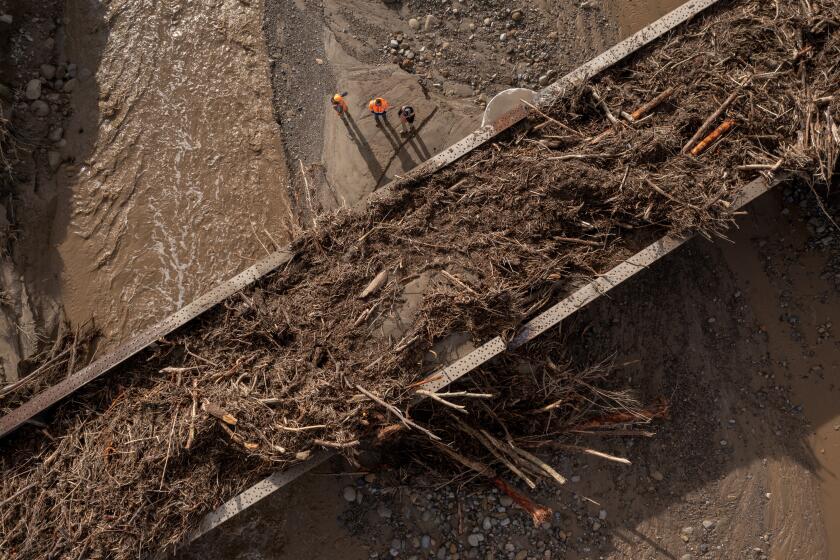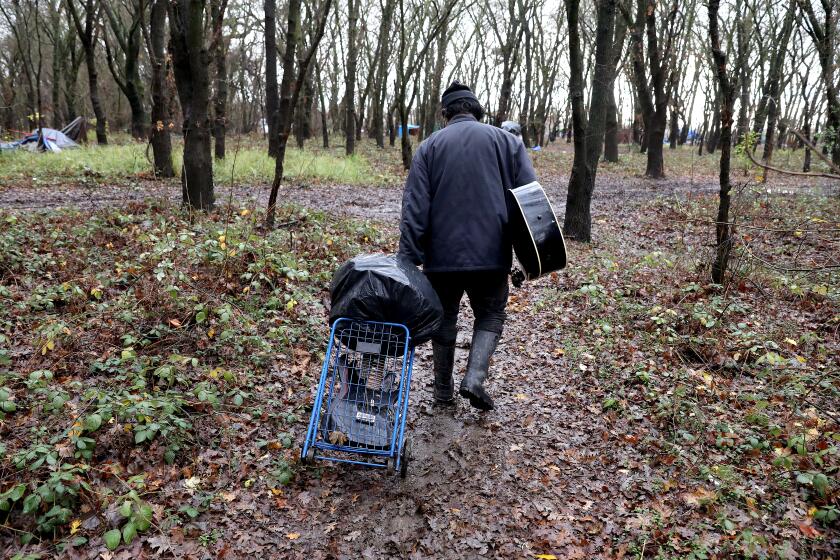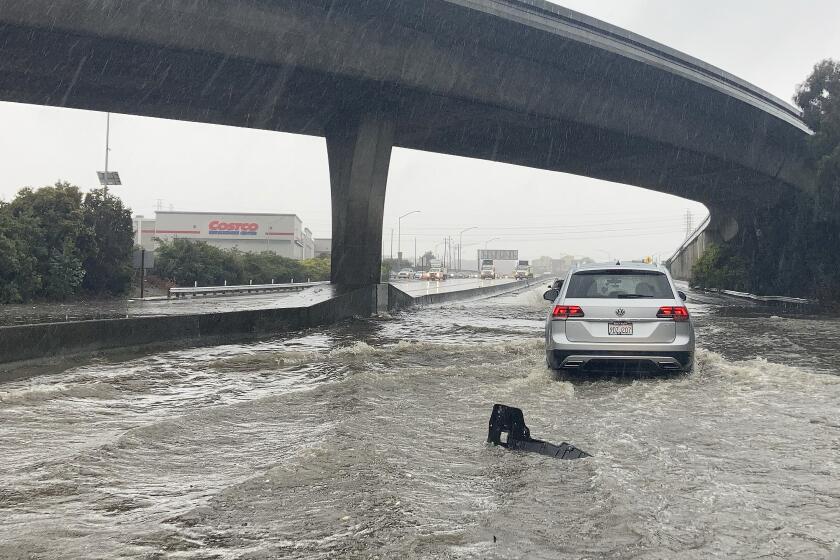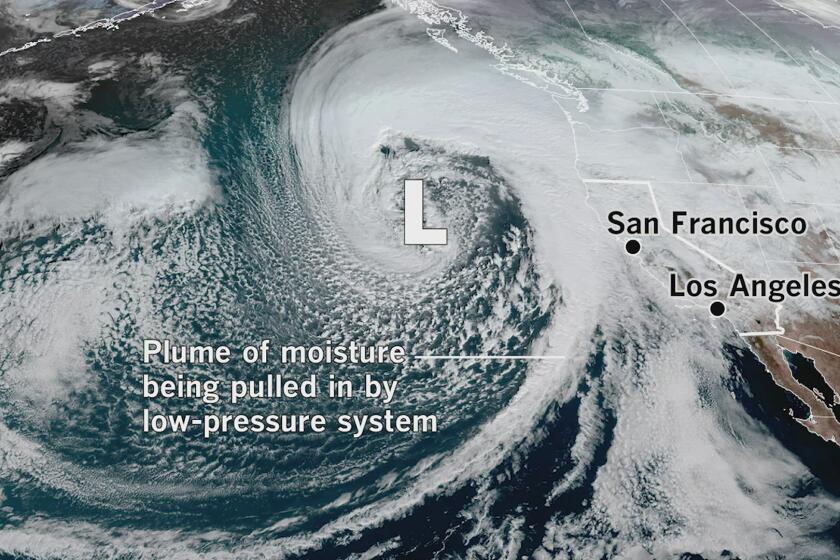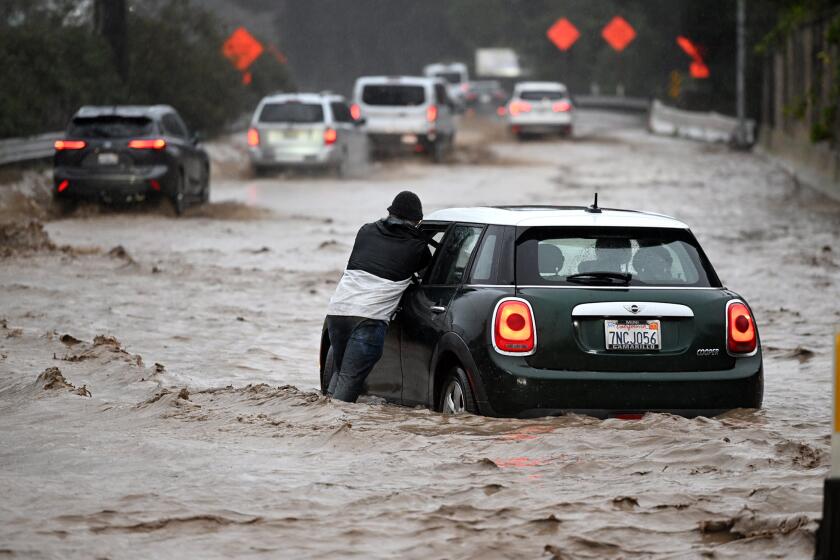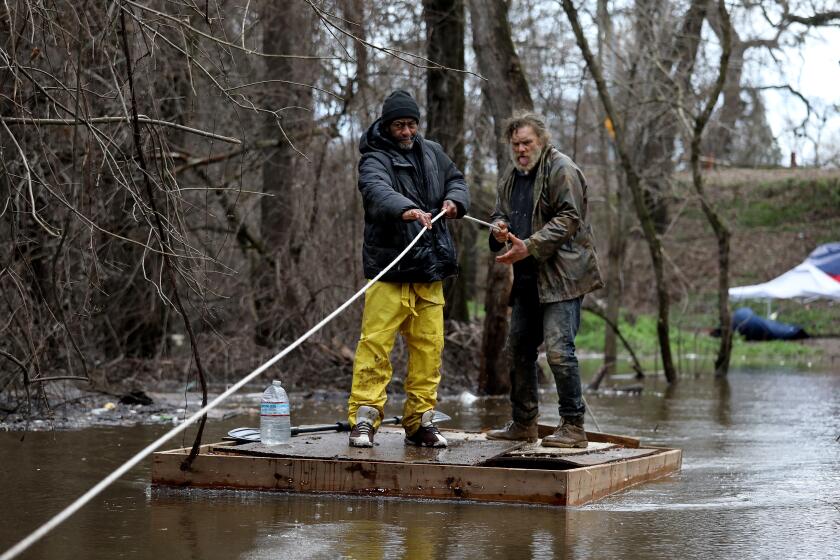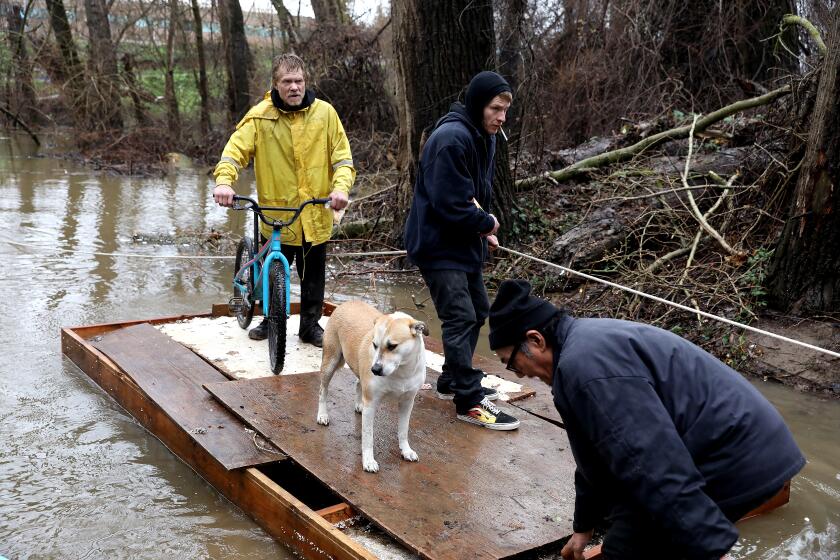‘Life-threatening’ flooding feared in Northern California as storms cause rivers to swell
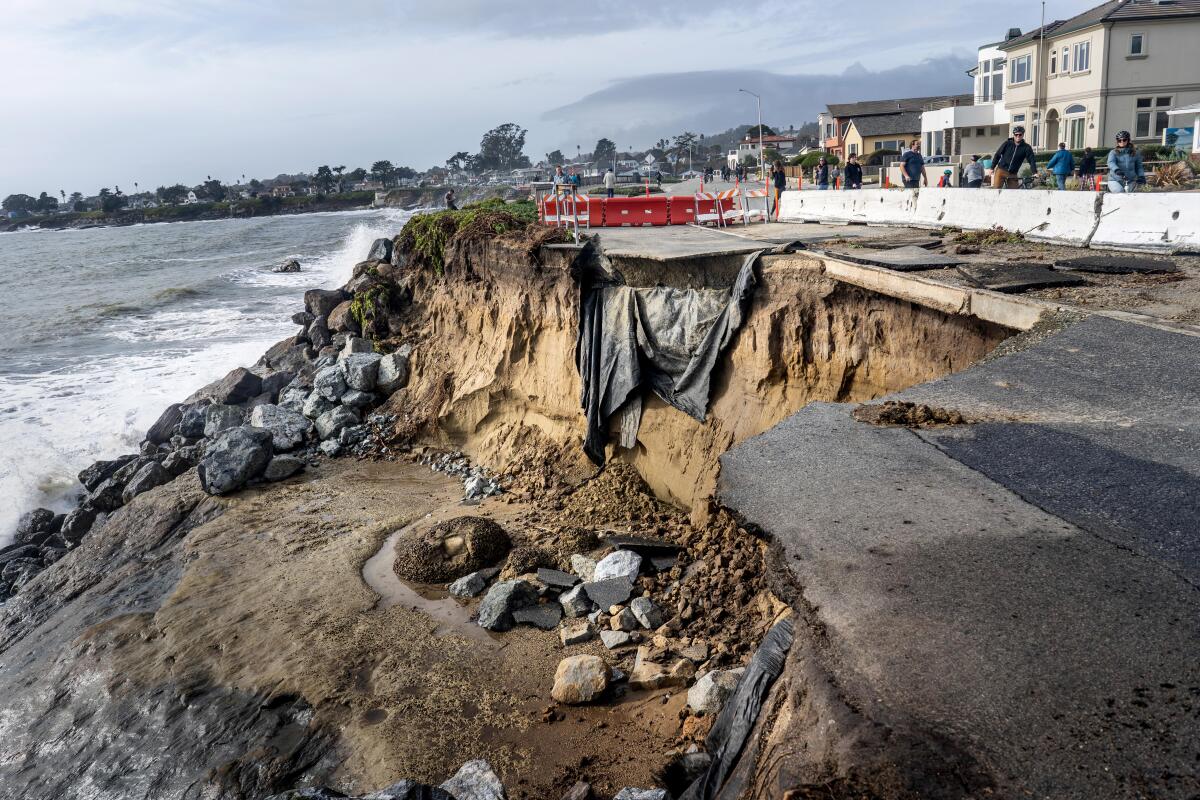
CAPITOLA, Calif. — Another in a series of powerful winter storms unleashed heavy rain in Northern California on Monday, causing widespread flooding in Santa Cruz County and beyond as rivers began to swell across the region.
The unrelenting extreme weather has produced giant swells that have wreaked havoc on coastal communities, strong winds that have toppled trees and knocked out power for thousands and intense rain that’s helped push rivers and creeks to flood stage. Officials say more wet weather is on the horizon.
“This is just the middle of what has already been a very wet and active pattern — and what is expected to be one, really, for at least another week or so,” said Daniel Swain, a climate scientist at UCLA.
Major flooding occurred in the mountains north of Santa Cruz, where floodwaters reached chest-high levels in Felton and elsewhere. The San Lorenzo River, which runs from the Santa Cruz Mountains downstream to Santa Cruz, hit major flood levels, rising 8 feet above the level that marks flood stage.
Floodwaters also poured onto neighborhood streets in the Watsonville area, which is hemmed in by the Pajaro River and Corralitos and Salsipuedes creeks.
Near Gilroy, the full Uvas Reservoir was forced to send some floodwaters downstream, inundating Highway 101 south of Gilroy and flooding at least one home in an agricultural area nearly to the top of its first story. Both sides of 101 were forced to shut down for hours.
With roadways flooded, rescue crews in the Santa Cruz Mountains struggled to get into neighborhoods where residents reported being trapped in their homes and cars. The crews launched a jet ski to get through water.
The amount of rainfall recorded in places was remarkable, with more than 10 inches falling in just 24 hours at the Bonny Doon fire station in the Santa Cruz Mountains. But other areas were spared somewhat, including San Jose, which appeared to avoid major flooding of the sort seen in 2017, when a surprise flood along Coyote Creek forced more than 14,000 residents from their homes.
Along the Central Coast, in San Luis Obispo County, rescuers on Monday afternoon called off the search for a 5-year-old boy swept away by floodwaters when conditions became unsafe for divers to continue looking, according to the Sheriff’s Office. The boy was swept away as he and his mother were trying to cross a road that had been flooded.
Elsewhere in San Luis Obispo County, a motorist died after entering a flooded portion of Avila Beach Drive, according to the California Highway Patrol’s Coastal Division.
The powerful storm that knocked out power, toppled trees — including one that killed a toddler — and flooded homes along the coast in Santa Cruz continued its march through the region.
Early Monday, evacuations were underway and major flooding was reported in the Felton Grove neighborhood and Paradise Park after the San Lorenzo River rose over its banks and flowed out into the surrounding community. Videos posted on social media showed muddy water covering cars and rising up to stop signs in Felton Grove as the San Lorenzo River raged nearby, filled with logs and other debris.
Colin Eppard, 32, a Watsonville resident, drove by the San Lorenzo River on Monday morning during his commute and saw the river waters rush into the ocean, where it created a standing wave.
“I’ve never seen the San Lorenzo flowing like I’ve seen it right now,” he said.
Eppard, an avid surfer, said waves have started to break at certain surf spots along the coastline that only show up after “gigantic” storms like this one.
“Just driving along the coastline and watching the last two big pushes of these storms, I jokingly said to my wife that this could rearrange the whole coastline and it quite literally has,” he said.
The inclement weather forced Shane Terry, 33, a Felton resident, to take the day off Monday. He was starting his morning commute to San Francisco, where he works as a produce distributor, but turned back in his SUV when he encountered roads covered in about 3 feet of water.
Terry lives near the San Lorenzo River and watched Monday morning as its waters touched the bottom of the bridge spanning Graham Hill Road.
“I don’t think I’ve ever seen it this bad,” Terry said. “There was one storm like eight years ago that was really big, and a lot of streets couldn’t handle the water, but I don’t think it’s ever gotten this high.”
More than 400,000 customers were without power in California as the latest powerful winter storm pushed through, elevating flooding danger.
Flooding and landslides across the region made travel challenging as people evacuated.
Southbound Highway 17 was blocked between San Jose and Santa Cruz. Areas in the Santa Cruz Mountains along Highway 9 between Santa Clara County and Santa Cruz were closed due to flooding and landslides.
East of Santa Cruz, in Soquel, the parking lot behind JJ’s Saloon was 3 inches deep with mud. That didn’t stop patrons from gingerly — or not — stepping through the muck to get a drink.
Bartender Jeff Ferreira, 56 — son of bar owner Judy Ferreira — said JJ’s Saloon has been flooded three times since New Year’s Eve. The worst, he said, was last week when the river rose and flooded downtown. He pointed to photos on his phone showing water in the back parking lot that had gone up and over the back stairs to the bar.
“Had to be a couple of feet,” he said, showing another video of a flooded Soquel Drive, which had waves and ripples on its surface.
Nearby, in the seaside town of Capitola, which sustained severe damage during last week’s storms, also faced additional flooding Monday.
Joshua Fisher, a property manager in downtown Capitola, said a few of his buildings were inundated — including the Left Coast Sausage Worx on San Jose Avenue — a block from the beach.
He said the high surf pushed the swollen river’s waters — and debris — into the streets. “Trees, propane tanks, the waves just pushed everything” into downtown, he said.
When an evacuation order reaches you, you need to leave. Now. Here’s how to prepare and what to have ready to go if you may need to evacuate during the rainstorms hitting California.
At the entrance of Esplanade, the small street that parallels the beach in downtown Capitola, Craig French stood talking with Mick and Patty Ruth. French, former president of the Santa Cruz County Board of Supervisors, said the destruction, waves and swollen river reminded him of the storm in 1982 — when waves crushed the end of the wharf and parts of town flooded.
“We haven’t seen anything this bad in 40 years,” he said.
Mick Ruth, a former Capitola mayor, agreed. Although, he said, the rain so far hasn’t been quite as bad as 1982. He said they’d recorded 18 inches over a 24-hour period in the mountains that year. This year has been wet — he’s recorded 32 inches since Sept. 1.
“And it’s not over yet,” he said.
In Monterey County, the Carmel River reached flood stage Monday morning. The rising waters prompted officials to issue an evacuation warning along the Carmel Valley.
At Robles del Rio in the Carmel Valley, the river had risen to 12.69 feet, above the flood stage at 8½ feet, before starting to decline.
At that level, the weather service said, many homes in low-lying areas all along the Carmel River are threatened, including near Camp Steffani, and the Carmel Lagoon area.
Residents along the edge of the river worked quickly to place sandbags outside their homes as the waterway raged.
UCLA’s Swain noted the atmospheric river is kind of “draped along the Central Coast,” with the heaviest rainfall from about Monterey County into Santa Barbara County, although there are also heavy rains extending southwest and northeast, he said.
While atmospheric rivers can cause flooding and mudslides, many are weak and can provide beneficial rain to drought-stricken California.
There are also potential convective elements such as thunderstorms, which are “the kinds of conditions that have a tendency to produce significant flash flooding and debris flows in the transverse ranges of Southern California, in particular along the Big Sur coasts,” he said.
“This is a major, potentially life-threatening event, but ... I don’t think we can call it the catastrophic flood that California has been worried about,” he added. “This is neither as intense nor as long in duration nor as widespread as the kind of events that we are talking about, although it certainly gives us a taste of what things look like as we head a little bit more in that direction.”
It’s not just the total amount of rain that matters, but how quickly it falls, Swain said, noting that “rainfall rates during the storm — or the maximum amount of precipitation per hour — have been pretty high, and that is indeed why we’re seeing such significant flooding in some areas.”
Late Sunday, President Biden approved an emergency declaration for California that authorizes the Federal Emergency Management Agency to coordinate disaster relief efforts and provide emergency resources, the White House said in a statement.
The toll of the storm includes a 5-year-old boy who was swept away by floodwaters and a motorist who died after entering a flooded roadway.
Fourteen people have died in the series of storms in the last 10 days, more civilians than have died in wildfires in the last two years.
Those killed include a 2-year-old boy who died when a tree fell on his home in Sonoma County last week and two homeless people — 40-year-old Rebekah Rohde and 61-year-old Steven Sorensen — who died in storm-related incidents in Sacramento County over the weekend, officials said.
“These floods are deadly and have now turned to be more deadly than even the wildfires here in the state of California,” Gov. Gavin Newsom said.
With storms battering Northern California, the dozens who live in tents on Bannon Island are among the most at risk.
About 68,000 Pacific Gas & Electric customers remain without power across the state. The utility noted in a statement that it has more than 4,000 workers responding to the storm and attempting to restore service.
“In some portions of the service area, high winds, flooding, and soil instability issues have made it unsafe for crews to work, which may lead to extended outages for our customers,” the utility said in a statement.
Early Monday amid a downpour, cars proceeded slowly along the peninsula’s Interstate 280, which runs along the San Andreas fault through the foothills of the Santa Cruz Mountains. Usually a high-speed thoroughfare — where traffic seems to cruise around 80 mph — the few drivers who were out were crawling, taking the occasional hydroplane with care.
Along Woodland Avenue in Menlo Park, where emergency officials warned that the San Francisquito Creek could flood, sandbags were piled high along the creek edge in segments. Several driveways were also barricaded.
San Jose is one of several locations where flood risks have heightened considerably as new storms barrel into Northern California, swelling rivers.
The weather service Monday said plenty of flooding could still occur late in the day “as some streams and creeks continue to rise in response to the runoff, while others are on the decline.”
As a result, flooding along some rivers could happen even after the rain stops Tuesday because of continuing runoff, said Brayden Murdoch, a meteorologist with the National Weather Service in the Bay Area.
“Some of the peaks are actually going to be between systems,” he said. “But there’s already quite a strain on some of our main rivers in the area as well as lagoons and deltas.”
California Department of Water Resources Director Karla Nemeth called the storm system “extraordinary,” but also “another climate signal” of California’s worsening swings between extreme conditions.
The state is coincidentally experiencing both a drought emergency and a flood emergency, she said.
Rust reported from Capitola, Fry from Orange County, Smith and Summer Lin from Los Angeles County and Rong-Gong Lin II from San Francisco. Times staff writers Brittny Mejia and Ruben Vives contributed to this report.
More to Read
Sign up for Essential California
The most important California stories and recommendations in your inbox every morning.
You may occasionally receive promotional content from the Los Angeles Times.
